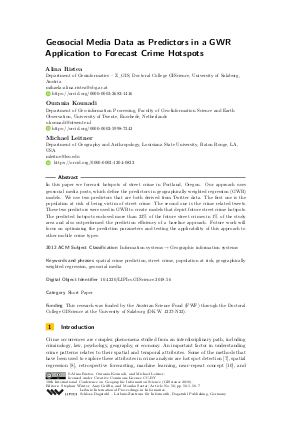Geosocial Media Data as Predictors in a GWR Application to Forecast Crime Hotspots (Short Paper)
Authors
Alina Ristea  ,
Ourania Kounadi
,
Ourania Kounadi  ,
Michael Leitner
,
Michael Leitner 
-
Part of:
Volume:
10th International Conference on Geographic Information Science (GIScience 2018)
Part of: Series: Leibniz International Proceedings in Informatics (LIPIcs)
Part of: Conference: International Conference on Geographic Information Science (GIScience) - License:
 Creative Commons Attribution 3.0 Unported license
Creative Commons Attribution 3.0 Unported license
- Publication Date: 2018-08-02
File

PDF
LIPIcs.GISCIENCE.2018.56.pdf
- Filesize: 382 kB
- 7 pages
Document Identifiers
Subject Classification
ACM Subject Classification
- Information systems → Geographic information systems
Keywords
- spatial crime prediction
- street crime
- population at risk
- geographically weighted regression
- geosocial media
Metrics
- Access Statistics
-
Total Accesses (updated on a weekly basis)
0PDF Downloads0Metadata Views
Abstract
In this paper we forecast hotspots of street crime in Portland, Oregon. Our approach uses geosocial media posts, which define the predictors in geographically weighted regression (GWR) models. We use two predictors that are both derived from Twitter data. The first one is the population at risk of being victim of street crime. The second one is the crime related tweets. These two predictors were used in GWR to create models that depict future street crime hotspots. The predicted hotspots enclosed more than 23% of the future street crimes in 1% of the study area and also outperformed the prediction efficiency of a baseline approach. Future work will focus on optimizing the prediction parameters and testing the applicability of this approach to other mobile crime types.
Cite As Get BibTex
Alina Ristea, Ourania Kounadi, and Michael Leitner. Geosocial Media Data as Predictors in a GWR Application to Forecast Crime Hotspots (Short Paper). In 10th International Conference on Geographic Information Science (GIScience 2018). Leibniz International Proceedings in Informatics (LIPIcs), Volume 114, pp. 56:1-56:7, Schloss Dagstuhl – Leibniz-Zentrum für Informatik (2018)
https://doi.org/10.4230/LIPIcs.GISCIENCE.2018.56
BibTex
@InProceedings{ristea_et_al:LIPIcs.GISCIENCE.2018.56,
author = {Ristea, Alina and Kounadi, Ourania and Leitner, Michael},
title = {{Geosocial Media Data as Predictors in a GWR Application to Forecast Crime Hotspots}},
booktitle = {10th International Conference on Geographic Information Science (GIScience 2018)},
pages = {56:1--56:7},
series = {Leibniz International Proceedings in Informatics (LIPIcs)},
ISBN = {978-3-95977-083-5},
ISSN = {1868-8969},
year = {2018},
volume = {114},
editor = {Winter, Stephan and Griffin, Amy and Sester, Monika},
publisher = {Schloss Dagstuhl -- Leibniz-Zentrum f{\"u}r Informatik},
address = {Dagstuhl, Germany},
URL = {https://drops.dagstuhl.de/entities/document/10.4230/LIPIcs.GISCIENCE.2018.56},
URN = {urn:nbn:de:0030-drops-93845},
doi = {10.4230/LIPIcs.GISCIENCE.2018.56},
annote = {Keywords: spatial crime prediction, street crime, population at risk, geographically weighted regression, geosocial media}
}
Author Details
- Department of Geoinformatics – Z_GIS, Doctoral College GIScience, University of Salzburg, Austria
- Department of Geo-information Processing, Faculty of Geo-Information Science and Earth Observation, University of Twente, Enschede, Netherlands
Funding
This research was funded by the Austrian Science Fund (FWF) through the Doctoral College GIScience at the University of Salzburg (DK W 1237-N23).
References
- Meshrif Alruily. Using text mining to identify crime patterns from arabic crime news report corpus. Thesis, DeMontfort University, 2012. URL: http://hdl.handle.net/2086/7584.
- Johannes Bendler, Tobias Brandt, Sebastian Wagner, and Dirk Neumann. Investigating crime-to-twitter relationships in urban environments-facilitating a virtual neighborhood watch. In ECIS 2014, 2014. URL: http://aisel.aisnet.org/ecis2014/proceedings/track11/10/.
-
Chris Brunsdon, A Stewart Fotheringham, and Martin E Charlton. Geographically weighted regression: a method for exploring spatial nonstationarity. Geographical analysis, 28(4):281-298, 1996.

-
Joel M Caplan and Leslie W Kennedy. Risk terrain modeling compendium. Rutgers Center on Public Security, Newark, 2011.

-
Spencer Chainey, Lisa Tompson, and Sebastian Uhlig. The utility of hotspot mapping for predicting spatial patterns of crime. Security Journal, 21(1):4-28, 2008.

-
Xinyu Chen, Youngwoon Cho, and Suk young Jang. Crime prediction using twitter sentiment and weather. In Systems and Information Engineering Design Symposium (SIEDS), 2015, pages 63-68. IEEE, 2015.

-
JE Eck, S Chainey, JG Cameron, M Leitner, and RE Wilson. Mapping crime: Understanding hot spots. national institute of justice. Washington, DC, 2005.

-
A Stewart Fotheringham, Chris Brunsdon, and Martin Charlton. Geographically weighted regression: the analysis of spatially varying relationships. John Wiley &Sons, 2003.

- Matthew S Gerber. Predicting crime using twitter and kernel density estimation. Decision Support Systems, 61:115-125, 2014. URL: http://dx.doi.org/10.1016/j.dss.2014.02.003.
-
Philip Glasner and Michael Leitner. Evaluating the impact the weekday has on near-repeat victimization: A spatio-temporal analysis of street robberies in the city of vienna, austria. ISPRS International Journal of Geo-Information, 6(1):3, 2016.

- Ourania Kounadi, Alina Ristea, Michael Leitner, and Chad Langford. Population at risk: using areal interpolation and twitter messages to create population models for burglaries and robberies. Cartography and Geographic Information Science, pages 1-15, 2017. URL: http://dx.doi.org/15230406.2017.1304243.
- Nick Malleson and Martin A Andresen. The impact of using social media data in crime rate calculations: shifting hot spots and changing spatial patterns. Cartography and Geographic Information Science, 42(2):112-121, 2015. URL: http://dx.doi.org/10.1080/15230406.2014.905756.
-
Nick Malleson and Martin A Andresen. Exploring the impact of ambient population measures on london crime hotspots. Journal of Criminal Justice, 46:52-63, 2016.

-
Walt L Perry. Predictive policing: The role of crime forecasting in law enforcement operations. Rand Corporation, 2013.

- Alina Ristea, Justin Kurland, Bernd Resch, Michael Leitner, and Chad Langford. Estimating the spatial distribution of crime events around a football stadium from georeferenced tweets. ISPRS International Journal of Geo-Information, 7(2):43, 2018. URL: http://www.mdpi.com/2220-9964/7/2/43.
-
Xiaofeng Wang, Matthew S Gerber, and Donald E Brown. Automatic crime prediction using events extracted from twitter posts. In International conference on social computing, behavioral-cultural modeling, and prediction, pages 231-238. Springer, 2012.

